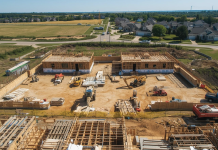Three trends are reshaping construction.
Technology integration, sustainable materials, and workforce evolution are changing how projects get planned, funded, and executed.
Each creates new competitive opportunities.
Technology Integration Accelerates Beyond Software
Integrated systems now replace isolated digital tools across project management, site monitoring, and resource allocation.
Real-time data streams connect design decisions directly to material costs, labor scheduling, and regulatory compliance. This cuts project timelines while improving accuracy.
The practical impact shows up in bid processes. Contractors using integrated systems are consistently underbidding traditional approaches while maintaining higher profit margins.
Sustainability Requirements Drive Material Innovation
Carbon-neutral concrete, recycled steel, and bio-based insulation have moved from experimental to production scale.
These materials now exceed traditional options in durability, cost, and environmental impact.
The shift is economic, not just environmental. Projects meeting advanced sustainability standards are securing financing at rates that make green building the financially smart choice.
Workforce Dynamics Reshape Project Delivery
Skilled trades command premium rates while embracing technology that amplifies their expertise.
Smaller, highly skilled crews using advanced tools deliver higher quality results with better safety records and more predictable timelines.
The labor shortage is becoming a competitive advantage for companies that understand how to leverage skilled workers with the right technology support.
Market Signals Point to Structural Change
Projects integrating advanced technology, sustainable materials, and optimized workforce approaches outperform traditional methods across all key metrics.
Integrated approaches deliver 20-30% better outcomes in timeline adherence, budget accuracy, and quality metrics.
What This Means for Construction Professionals
Companies understanding these trend intersections gain sustained competitive advantages.
Successful firms invest now in technology integration, sustainable material partnerships, and workforce development.
Professional success depends on understanding how these trends work together, not treating them as separate challenges.








